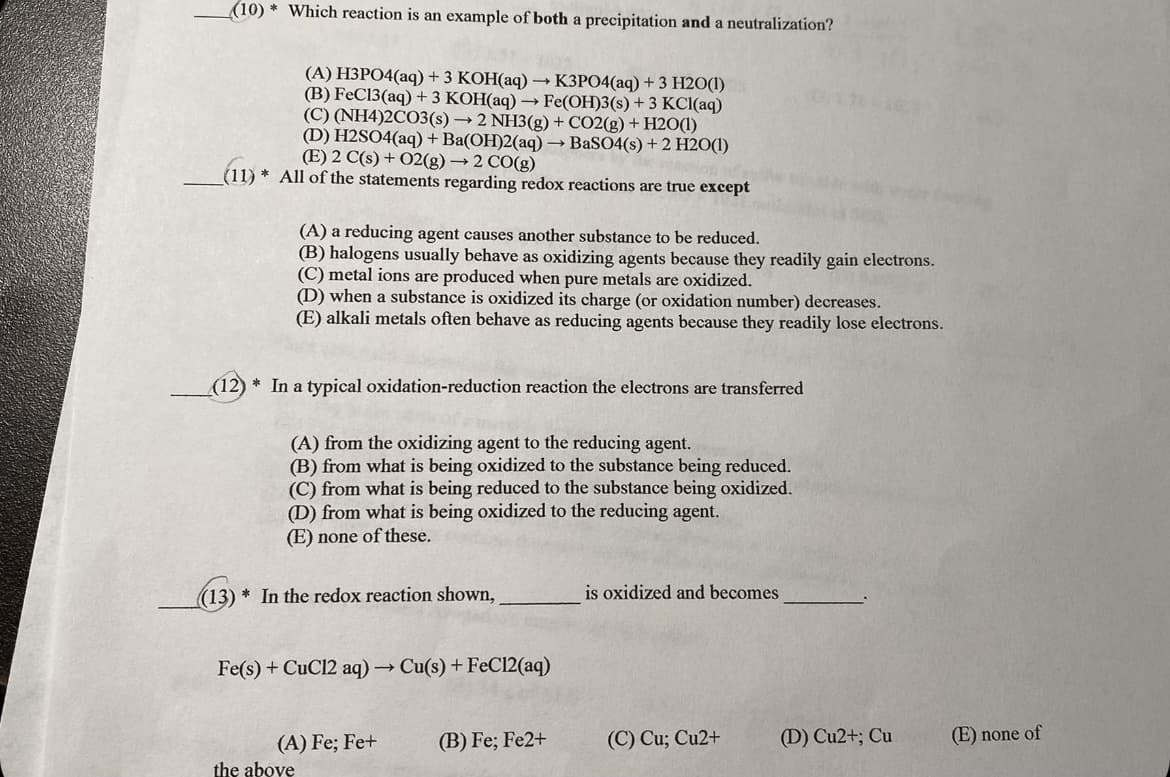Which reaction is an example of both a precipitation and a neutralization? (A) H3PO4(aq) + 3 KOH(aq) –→ K3PO4(aq) + 3 H2O(I) (B) FeC13(aq) + 3 KOH(aq) → Fe(OH)3(s) + 3 KCI(aq) (C) (NH4)2CO3(s) → 2 NH3(g) + CO2(g) + H20(1) (D) H2SO4(aq) + Ba(OH)2(aq) → BaSO4(s) + 2 H2O(1) (E) 2 C(s) + 02(g) → 2 CO(g) (11) * All of the statements regarding redox reactions are true except (A) a reducing agent causes another substance to be reduced. (B) halogens usually behave as oxidizing agents because they readily gain electrons. (C) metal ions are produced when pure metals are oxidized. (D) when a substance is oxidized its charge (or oxidation number) decreases. (E) alkali metals often behave as reducing agents because they readily lose electrons. (12) * In a typical oxidation-reduction reaction the electrons are transferred (A) from the oxidizing agent to the reducing agent. (B) from what is being oxidized to the substance being reduced. (C) from what is being reduced to the substance being oxidized. (D) from what is being oxidized to the reducing agent. (E) none of these.
Which reaction is an example of both a precipitation and a neutralization? (A) H3PO4(aq) + 3 KOH(aq) –→ K3PO4(aq) + 3 H2O(I) (B) FeC13(aq) + 3 KOH(aq) → Fe(OH)3(s) + 3 KCI(aq) (C) (NH4)2CO3(s) → 2 NH3(g) + CO2(g) + H20(1) (D) H2SO4(aq) + Ba(OH)2(aq) → BaSO4(s) + 2 H2O(1) (E) 2 C(s) + 02(g) → 2 CO(g) (11) * All of the statements regarding redox reactions are true except (A) a reducing agent causes another substance to be reduced. (B) halogens usually behave as oxidizing agents because they readily gain electrons. (C) metal ions are produced when pure metals are oxidized. (D) when a substance is oxidized its charge (or oxidation number) decreases. (E) alkali metals often behave as reducing agents because they readily lose electrons. (12) * In a typical oxidation-reduction reaction the electrons are transferred (A) from the oxidizing agent to the reducing agent. (B) from what is being oxidized to the substance being reduced. (C) from what is being reduced to the substance being oxidized. (D) from what is being oxidized to the reducing agent. (E) none of these.
Chemistry: Principles and Practice
3rd Edition
ISBN:9780534420123
Author:Daniel L. Reger, Scott R. Goode, David W. Ball, Edward Mercer
Publisher:Daniel L. Reger, Scott R. Goode, David W. Ball, Edward Mercer
Chapter14: Chemical Equilibrium
Section: Chapter Questions
Problem 14.97QE: According to the Resource Conservation and Recovery Act (RCRA), waste material is classified as...
Related questions
Question

Transcribed Image Text:(10) * Which reaction is an example of both a precipitation and a neutralization?
(A) H3PO4(aq) + 3 KOH(aq) –→ K3PO4(aq) + 3 H2O(1)
(B) FeC13(aq) + 3 KOH(aq) → Fe(OH)3(s) + 3 KCI(aq)
(C) (NH4)2CO3(s) → 2 NH3(g) + CO2(g) + H20(1)
(D) H2SO4(aq) + Ba(OH)2(aq) → BaSO4(s) + 2 H2O(1)
(E) 2 C(s) + 02(g) → 2 CO(g)
(11) * All of the statements regarding redox reactions are true except
(A) a reducing agent causes another substance to be reduced.
(B) halogens usually behave as oxidizing agents because they readily gain electrons.
(C) metal ions are produced when pure metals are oxidized.
(D) when a substance is oxidized its charge (or oxidation number) decreases.
(E) alkali metals often behave as reducing agents because they readily lose electrons.
(12)
In a typical oxidation-reduction reaction the electrons are transferred
(A) from the oxidizing agent to the reducing agent.
(B) from what is being oxidized to the substance being reduced.
(C) from what is being reduced to the substance being oxidized.
(D) from what is being oxidized to the reducing agent.
(E) none of these.
(13) * In the redox reaction shown,
is oxidized and becomes
Fe(s) + CuCl2 aq)→
Cu(s) + FeC12(aq)
(A) Fe; Fe+
(B) Fe; Fe2+
(C) Cu; Cu2+
(D) Cu2+; Cu
(E) none of
the above
Expert Solution
This question has been solved!
Explore an expertly crafted, step-by-step solution for a thorough understanding of key concepts.
This is a popular solution!
Trending now
This is a popular solution!
Step by step
Solved in 4 steps with 4 images

Knowledge Booster
Learn more about
Need a deep-dive on the concept behind this application? Look no further. Learn more about this topic, chemistry and related others by exploring similar questions and additional content below.Recommended textbooks for you

Chemistry: Principles and Practice
Chemistry
ISBN:
9780534420123
Author:
Daniel L. Reger, Scott R. Goode, David W. Ball, Edward Mercer
Publisher:
Cengage Learning

Chemistry for Engineering Students
Chemistry
ISBN:
9781337398909
Author:
Lawrence S. Brown, Tom Holme
Publisher:
Cengage Learning

Chemistry: Principles and Practice
Chemistry
ISBN:
9780534420123
Author:
Daniel L. Reger, Scott R. Goode, David W. Ball, Edward Mercer
Publisher:
Cengage Learning

Chemistry for Engineering Students
Chemistry
ISBN:
9781337398909
Author:
Lawrence S. Brown, Tom Holme
Publisher:
Cengage Learning